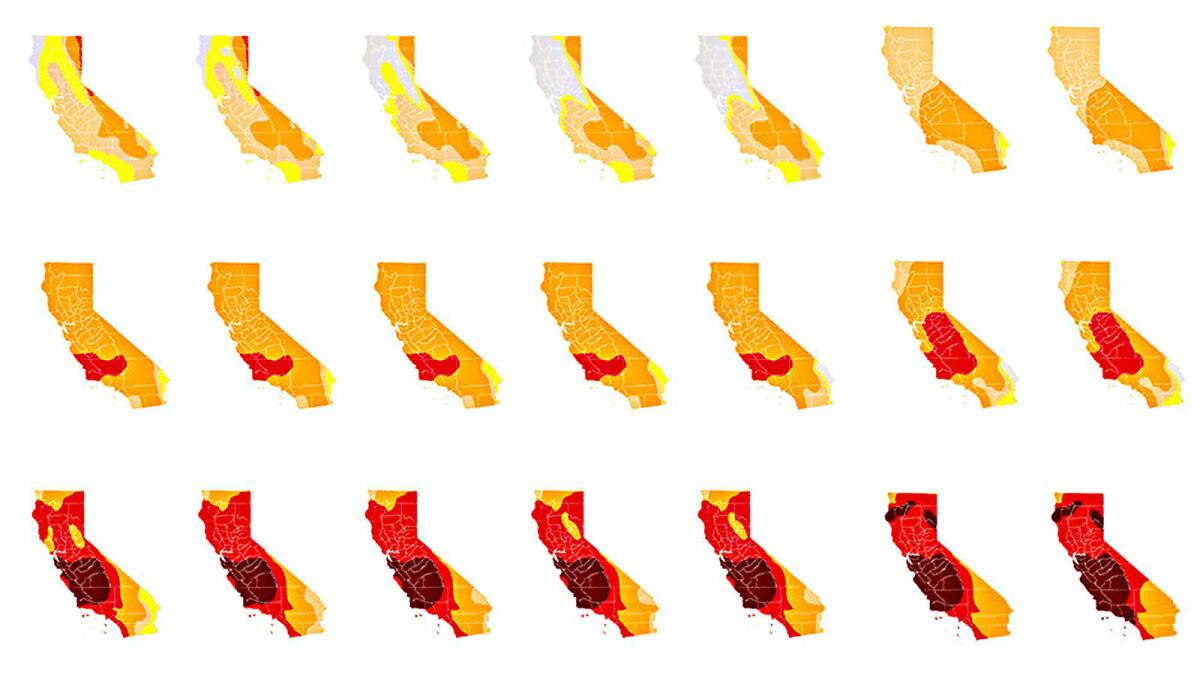Newsletter: Water and Power: The place that still has water
Your guide to the California drought from the Los Angeles Times.
NEWS AND POLICY
Future water policies: The water sector may well take a cue from the energy industry when it looks to the future on conservation. Water officials are hoping to use a mix of customer awareness, more efficient technologies and new policies governing groundwater and rainwater capture. "The reality is that there are so many soft paths that we can take that might have a lot less environmental impact and be a lot less expensive, and still meet our future demand," said Newsha Ajami, director of urban water policy for Stanford's Water in the West initiative.
Exception to the rule: While the Central Valley has been ravaged by the drought, another key California agricultural region -- the Salinas Valley -- is in much better shape. Unlike the Central Valley, which depends on snowmelt transported from faraway reservoirs, the Salinas Valley has prospered for decades relying solely on the groundwater hundreds of feet below. A county report estimates there are about 5.3 trillion gallons of water stored underground. About 3% to 4% of that amount is pumped out each year. Thanks to all that water, the region produces about $8.1 billion a year for the economy.
Weather patterns: A new video from the National Weather Service explains what kind of impact an El Niño system may have on California this winter. “One El Niño year will help, if it actually brings rain to California, which is not guaranteed. But we need a few years in a row of above-average precipitation to dig out of this monumental hole that we’re in,” said Jay Famiglietti, senior water scientist with NASA's Jet Propulsion Lab.
ON THE GROUND
Fake out: For some homeowners who replaced their water-gulping grass lawns with artificial turf, there has been a Catch-22. Their efforts to help the drought run into conflict with local laws than prohibit fake grass. Now, Gov. Jerry Brown has signed a bill that protects these residents from sanctions by homeowner associations under one of 10 bills he signed Friday. “The grass may be fake, but the amount of water a homeowner can save by installing it is very real,” said Assemblywoman Lorena Gonzalez (D-San Diego), the bill’s author.
Heat exhaustion: The state’s drought conditions are making it even more dangerous for farmworkers in Central California. Hot weather conditions and a lack of available water make it dangerous for employees to continue to work the fields. “A decade after California implemented the heat illness emergency resolutions, some growers in one of the most agriculturally rich parts of the country still have yet to ensure protections for farmworkers who work prolonged hours during peak heat times.”
Dire conditions: The people of East Porterville continue to live with the devastating effects of wells running dry. They rely on bottled water or hose water hooked up from a neighbor’s supply. “The community doesn't have a public water system; instead, residents rely on private wells. But after years of drought, the nearby Tule River has diminished to a trickle and the underground water table has sunk as more and more farmers rely on groundwater.”
Dry campus: The campuses of UCLA and San Diego State University have been declared “drought endangered” campuses. The list is intended to bring attention to how much water institutions use. “It’s just another reminder that water is a precious resource, and any campus that’s in an extreme drought needs to be on high alert of water use,” according to the author of the LawnStarter list.
OFFBEAT
Behind bars: Even jail officials are stepping up to conserve water. At Orange County’s largest jail, authorities have torn out turf and installed low-flow toilets and new shower heads. The moves could save Theo Lacy jail 775,000 gallons of water every month.
Rediscovering history: A drop in water levels has exposed historic Native American sites. But some tourists are celebrating by actually taking the artifacts, like spearheads, home with them. “In mid-August, several members of the Lake County Sheriff's Office attended training on illegal looting of artifacts, and learned that many times looters are looking for quick cash to buy drugs.”
BIG IDEAS
“We’ve been in drought. People feel that their property is not at the same level of risk as during a non-drought year.”
--Ricardo Pineda, a supervising engineer in the flood management division of the California Department of Water Resources, on how the drought is prompting many to cancel their flood insurance.
“Two underlying conditions have stoked these fires: a western drought that's stretching into its fourth year and high temperatures that are unprecedented — 2014 was the warmest year on record, and so far 2015 has proved even hotter. The result has been a tinder-dry region unusually vulnerable to lightning strikes or human-caused fires.”
--National Geographic on the link between drought and Western wildfires.
DROUGHT SNAPSHOT
192 drought maps reveal just how thirsty California has become. (Los Angeles Times)
DAILY TIP
If you’re in Burbank, you can pick up free recycled water through the end of October. Residents and business owners may take up to 300 gallons at a time. Just remember that when it comes to recycled water, don’t drink it.
LOOKING AHEAD
Tuesday: The L.A. Board of Water and Power Commissioners will meet.
Please let us know what we can do to make this newsletter more useful to you. Send comments, complaints and ideas to Alice Walton or Shelby Grad.
Start your day right
Sign up for Essential California for news, features and recommendations from the L.A. Times and beyond in your inbox six days a week.
You may occasionally receive promotional content from the Los Angeles Times.





